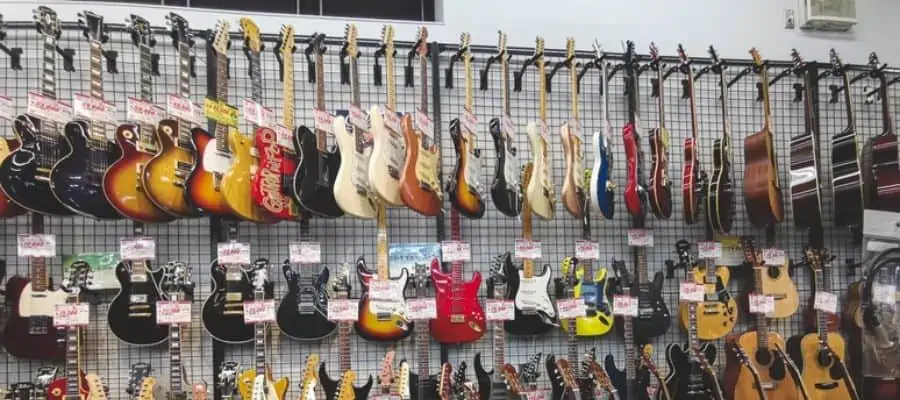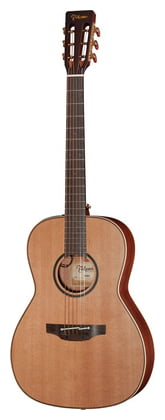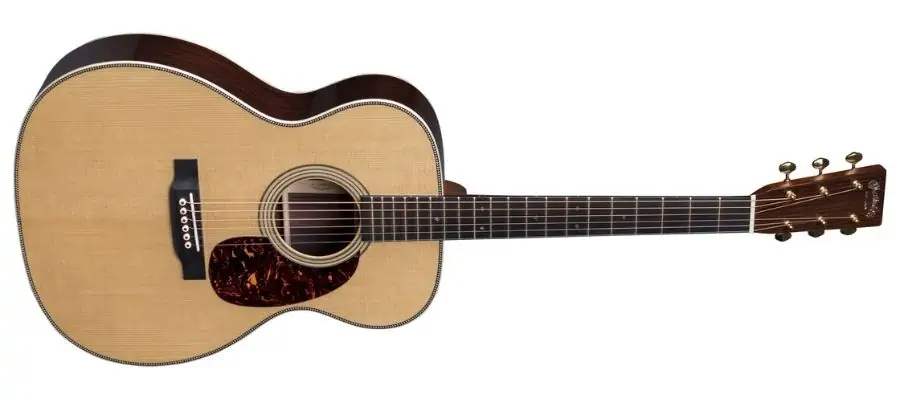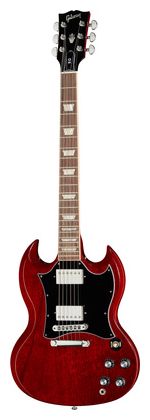Do you want to get yourself a guitar? Fortunately, there are many different models you can find on the market. But the question is, what happens if you have smaller hands? One of the options for you is to go for a smaller guitar or something that won’t be as challenging to play.
So, whether you are buying a guitar for yourself or your kid, getting a smaller model is the simplest way to solve the problem. It will allow you to learn the basics without struggling along the way.
Keep in mind that these aren’t guitars for kids and you can still play them as regular instruments.
Top 15 Acoustic Guitars For Small Hands

Now, the main question here is whether you want to get yourself an acoustic or electric guitar. So, let’s start with acoustics and take a look at the models you can find in various price ranges.
Cordoba Mini II
- Comfortable 1/2 size guitar, with standard tuning
- Layered Mahogany top, back and sides
- Nub one nut, 1. 875" Width
- C-profile Mahogany neck; 22. 875" Scale Length
- Size: ½ size
- Body: Mahogany
- Scale length: 22.875” (581 mm)
- Neck: Mahogany with Morado fretboard
Cordoba Mini is an excellent choice for all the beginners out there, especially children. The size of the guitar is ½, which makes it perfect for those with smaller hands. Ideally, younger beginners would go for a guitar with smaller body size and thinner neck.
This will allow them to easily play chords without struggling. One of the main advantages of the Cordoba Mini II is that the guitar is quite cheap. You won’t need to spend a ton of money on it, and it sounds really good.

Ibanez 3/4 Mini Dreadnought
- 6-string Acoustic Guitar with Sapele Top
- Nu Fingerboard - Natural
- Mahogany Neck
- Back Sides
- Size: ¾ size
- Body: Mahogany
- Scale length: 22.8” (579 mm)
- Neck: Mahogany with rosewood fretboard
Dreadnought guitars are rarely a good option for beginners. They can be too large and too challenging to play. But this Ibanez is a ¾ version of the dreadnought model, and it is incredible.
Ibanez is known for excellent quality and unique design, and you can get this affordable model for you or your friend/family member. The most important thing is that they won’t struggle with it thanks to the guitar’s size. The Ibanez Mini is made of mahogany, and it has a solid mahogany top.

Ibanez PN1
- 6-string Acoustic Guitar with Spruce Top
- Nu Fingerboard - Natural Gloss
- Nyatoh Back Sides
- Size: full size
- Body: Mahogany with spruce top
- Scale length: 24.4” (620 mm)
- Neck: Mahogany with rosewood fretboard
Going for the smaller guitar size or scale length is not the only solution. There are models that are designed to have smaller bodies but still have a similar performance as full-size guitars. Perfect examples are parlor or parlor guitars. The Ibanez PN1 has a smaller body, but the size of the neck (scale) is still normal.
If you are a fan of parlor guitars, this is one of the best models you can find without spending a fortune on it.

Fender FA-15N
- One right-handed Fender Acoustic Guitar and one Gig Bag
- Small Size, Same Sound: This smaller _-size body acoustic guitar is ideal...
- Smooth Tuning: The modern 3+3 headstock makes for an easy playing acoustic...
- Starting with Nylon: Combines the easy playability and quintessential sound...
- Size: ¾ size
- Body: Sapele with spruce top
- Scale length: 23.3″ (592 mm)
- Neck: Nato with walnut fretboard
Fender FA-15N is a ¾ guitar, and it comes with nylon strings. This means that the guitar is easy to play, and you won’t struggle with it at all. Nylon strings usually have less tension, which makes fretting a lot simpler.
The guitar has a natural color, and beautiful design and the smaller body is ideal for beginners. Essentially, it is a smaller version of the classical guitar designed by Fender. It is a perfect opportunity for you to get a real Fender for a low price.

Yamaha APXT2
- Spruce Top
- Rosewood Fingerboard & Bridge
- System 68 Pick-Up
- Gig bag Included
- Size: ¾ size
- Body: Meranti with spruce top
- Scale length: 22 13/16″ (580 mm )
- Neck: Tonewood with rosewood fretboard
Yamaha is one of the most popular brands of acoustic guitars, and they offer models in all price ranges. This one here is a ¾ model, and it comes in many different colors. What is also great is that it has a cutaway, which makes playing the higher notes significantly easier.
The size makes it comfortable for younger audiences and those that don’t want to struggle with huge guitars. It is worth mentioning that the guitar has a pickup system, and you can plug it into an amplifier or a speaker.

Fender CP-60S
- Solid Spruce Top with Laminated Mahogany Back and Sides
- 24.75" scale mahogany neck w/20 fret walnut fingerboard
- Chrome Die-Cast tuners
- Rosewood Bridge
- Size: Full size
- Body: Mahogany with solid spruce top
- Scale length: 24.75″ (628.7 mm )
- Neck: Mahogany with walnut fretboard
Fender CP-60S is a full-size parlor guitar, which makes it a perfect choice for those with smaller hands. As I mentioned earlier, parlor guitars have smaller bodies but they still have normal scale length.
This model is made of mahogany (back and sides) with a solid spruce top. The neck is easy to play, it’s made of mahogany with a walnut fretboard. The finish makes it look amazing, and it is quite comfortable.

Recording King RPS-9-TS
- Solid Sitka Spruce top
- 25.4" Scale Length
- Cross Lap bracing
- Bone nut & saddle
- Size: Full size
- Body: Spruce with solid spruce top
- Scale length: 25.4″ (645.2 mm )
- Neck: Spruce
Recording King RPS is based on vintage guitars from the thirties, and it sounds beautiful. This is a full-size guitar with a 25.4” scale length, it’s comfortable and perfect for blues. Naturally, you can use it to play any music genre you like.
The guitar is suitable for any skill level, and it is one of the best parlor models you can find in this price range.

Gretsch G9520E Gin Rickey
- Basswood body with X-bracing
- 12th fret, 24”-scale nato set neck with 12” radius walnut fingerboard
- Gretsch Deltoluxe soundhole pickup with gold/white rosette rings
- 1950s-style vintage open-gear die-cast tuning machines and vintage end-pin...
- Size: Full size
- Body: Basswood with solid spruce top
- Scale length: 24″ (609.6 mm )
- Neck: Nato with walnut fretboard
Gretsch is a company with a rich history and thousands of gorgeous instruments. The company has been around since 1883. If you are a fan of Gretsch, you should check out the G9520E model.
The guitar also comes with a pickup on the soundhole, and it will allow you to plug in the guitar if you want to play live. The neck on the guitar is quite comfortable, and it has a C-shaped profile.

Washburn Festival EA15
- Comfortable mini-jumbo cutaway Body is easier to play for those that find...
- Perfect for smaller players, young learners, or musicians looking for the...
- Flame Maple top, Catalpa back and sides with quarter sawn scalloped Sitka...
- Plug-in ready and pre-equipped with a Barcus-Berry pickup/electronics with...
- Size: Full size
- Body: Catalpa with maple top
- Scale length: 25-1/2″ (647.7 mm )
- Neck: Mahogany with engineered wood fretboard
For those that are looking for something different, Washburn Festival EA15 might be worth checking out. The guitar is a mini-jumbo. Jumbo guitars are often the largest models you can find, but the mini version is more comfortable for players.
Washburn Festival EA15 also comes with electronics, and there is a built-in tuner you can use. The guitar looks great and sounds even better, and the smaller size is perfect for those with smaller hands. It is worth mentioning that this model is slightly bigger than parlor guitars, but it is still not as big as regular jumbo instruments.

Taylor BT2 Baby Taylor
- 6-string Acoustic Guitar with Mahogany Top
- Layered Sapele Back
- Sides - Natural
- Neck Width 1-11/16 inch
- Size: Full size
- Body: Mahogany with Sapele back
- Scale length: 22-3/4″ (577.9 mm )
- Neck: Mahogany with ebony fretboard
Baby Taylor is one of the most popular smaller guitars. The price and quality of Baby Taylor are exceptional, and it is based on the dreadnought models. However, the body is quite small. One of the most important things is that the action is so low that those with smaller hands will love playing on it.
The overall design of the guitar is simple. It doesn’t have a pickguard, pickups, or anything flashy. But it is one of the best choices for smaller guitars.

Fender Paramount PM-2
- Mahogany back and sides provide a rich and balanced tone
- Grade "A" Sitka spruce top for strong and balanced projection
- The Mahogany neck with Ebony fingerboard provide comfort and a sharp attack
- Fishman-designed preamp
- Size: Full size
- Body: Mahogany with spruce top
- Scale length: 24.75″ (629 mm)
- Neck: Mahogany with peroba fretboard
Fender Paramount PM-2 is another parlor guitar, and it is incredible. Needless to say, when you go up the price range, guitars you will find there keep getting better and better. And Paramount is no different.
The guitar has a full sound thanks to the solid spruce top, it has a pickguard and electronics. It has a Fishman-designed preamp and even a tuner with a display. If you find an older model of Paramount, they are most likely to have a rosewood fretboard instead of peroba.

Fender Malibu Classic
- Fender-exclusive Malibu body shape
- Painted solid Sitka Spruce top; natural solid Mahogany back and sides
- Fender- and fishman-designed pickup/preamp system
- Includes deluxe Gig Bag
- Size: Full size
- Body: Mahogany with spruce top
- Scale length: 24.1″ (612 mm)
- Neck: Mahogany with Pau Ferro fretboard
Fender Malibu Classic looks almost like a hybrid between electric and acoustic guitars. It has a well-known Fender headstock, but the body is similar to parlor guitars. As a result, you will get one of the most comfortable instruments you can find.
The guitar also comes with a Fishman-preamp system, full EQ, and a built-in tuner. The guitar is easy to use and sounds wonderful. As you can probably guess, the model is available in many different colors.

Takamine P3NY New Yorker
- Size: Full size
- Body: Sapele with solid cedar top
- Scale length: 25.3″ (642.6 mm)
- Neck: Mahogany with rosewood fretboard
Another option you can check out is Takamine P3NY New Yorker. This is a beautiful model with parlor size. It has a Sapele cedar back, sides of laminated Sapele, and a solid cedar top. The neck is made of mahogany with rosewood fretboard and ivory binding.
Make no mistake, this is not a guitar designed for beginners, and honestly, there aren’t many beginners that could afford something like this. It is a professional-level guitar, with a gorgeous design. The guitar has electronics so you can easily plug it into the amp.

Fender Acoustasonic Stratocaster
- Hybrid Acoustic-electric Guitar with Mahogany Body
- Ebony Fingerboard - 3-Col Sunburst
- Mahogany Neck
- Spruce Top
- Size: Full size
- Body: Mahogany with Sitka spruce top
- Scale length: 25.5″ (648 mm)
- Neck: Mahogany with ebony fretboard
You might have seen something similar before. The Fender Acoustasonic series is based on well-known models of electric guitars. This one here is a Stratocaster version of Fender’s acoustic guitars. It is a hybrid model that has a pickup but also a resonator box.
What makes it so comfortable for beginners and those with smaller hands is the unique shape of the body and slimmer neck.

Martin 000-28
- Size: Full size
- Body: East Indian rosewood with Sitka spruce top
- Scale length: 24.9″ (632.5 mm)
- Neck: Select hardwood with ebony fretboard
Martin is the uncrowned king of acoustic guitars. If you want to get the best, you buy Martin. And there are models designed for everyone. Including those with smaller hands. Martin 000-28 is a gorgeous guitar with a smaller body and slimmer neck.
At least compared to other dreadnought models. Needless to say, Martin is one of the best manufacturers in the world, and guitars are everything but cheap. Most likely, these models will be played by professional guitarists.

Top 15 Electric Guitars For Small Hands

Acoustic and electric guitars are two different instruments. Many people believe that you have to buy the former one to start learning and only then move to the electric one. But this isn’t the case. Some people want to start with the electric guitar, and there is nothing wrong with that. So, let’s take a look at top electric guitars for those with small hands.
Ibanez GRGM
- High output Infinity R pickups
- Ideal for beginner & intermediate / Ibanez design every guitar, affordable...
- Style and Substance: Featuring a poplar body, maple neck and maple...
- Body: Poplar
- Neck: Maple with maple fretboard
- Pickups: Infinity R with HH configuration
- Scale length: 22.2” (563.9 mm)
Ibanez is a well-known brand and it offers guitars in all price ranges. With that, it has been the first guitar for many players out there. You can find great Ibanez models for a low price, and it is perfect for those that love heavier genres.
These models usually have HH, HSH, or HSS pickup configuration so you will get at least one humbucker. What is more important is that the neck is quite slim compared to other guitars. This makes playing so much easier.

Jackson Dinky Minion JS1X
- Sht-scale Solidbody Electric Guitar with Poplar Body
- 2 Humbucking Pickups - Black
- Amaranth Fretboard
- Maple Neck
- Body: Poplar
- Neck: Maple with amaranth fretboard
- Pickups: Jackson humbuckers with HH configuration
- Scale length: 22.5” (571.5 mm)
There are those who prefer Jackson over Ibanez. Both guitars started as Super Strats, and it is a matter of personal choice. If you do enjoy playing Jackson guitars, you might want to check out the Minion JS1X. It is a smaller version of the famous Dinky, and it is awesome.
The guitar has an HH configuration with two high-output Jackson pickups. The size of the neck is still normal, but the body is slightly smaller compared to the standard version.

Squier by Fender Mini Jazzmaster HH
- 100% Designed by Fender
- Thin and lightweight body
- Dual humbucking pickups
- Sealed die-cast tuning machines
- Body: Poplar with maple top
- Neck: Maple with maple fretboard
- Pickups: Dual humbucking pickups with HH configuration
- Scale length: 22.75” (578 mm)
Newer Fender guitars have incredible necks, at least for those with smaller hands. Some people prefer older models where the neck was thicker, but the Squier series of Fender is quite comfortable and well-made.
In addition, you can find numerous different mini models like Jazzmaster. It has an HH pickup configuration, with a standard scale length. The guitar has a similar shape to a Jaguar, but there are a few differences.

Squier by Fender Mini Stratocaster
- 100% designed by Fender
- Thin and lightweight body
- 22.75" scale length
- Three single-coil pickups
- Body: Poplar with maple top
- Neck: Maple with Indian laurel fretboard
- Pickups: Three single-coil pickups
- Scale length: 22.75” (578 mm)
If you are looking for a more traditional approach, the best option is Squier Mini Stratocaster. The guitar has a smaller body and slim neck which makes it perfect for younger players. Needless to say, these mini models are the cheapest Squiers you can find, so you shouldn’t expect a mind-blowing quality.
This doesn’t mean that they are not worth the price. You will have a hard time finding a better Stratocaster in this price range. And the size and design of the guitar are still great.

Ibanez GRX70QATBB
- Solidbody Electric Guitar with Poplar Body
- 1 Single-coil Pickup - Trans Blue Burst
- 2 Humbucking Pickups
- Jatoba Fingerboard
- Body: Mahogany with basswood back
- Neck: Maple with rosewood fretboard
- Pickups: Infinity R and RS pickups in HSH configuration
- Scale length: 25.5″ (647.7 mm)
The Ibanez GRX series is excellent for beginners, and the guitar is quite versatile thanks to its HSH configuration. Keep in mind that this is not a smaller version of the guitar, and it is a full-size model.
But Ibanez has thinner necks compared to other guitars, and it is easy to play. After all, the majority of Ibanez players are interested in shredding, and these models are perfect for it.

Squier Affinity Stratocaster
- Solidbody Electric Guitar with Poplar Body
- 1 Humbucking Pickup - Black Burst
- 2 Single-coil Pickups
- Maple Fingerboard
- Body: Poplar
- Neck: Maple with maple fretboard
- Pickups: Squier pickups in HSS configuration
- Scale length: 25.5″ (648 mm)
There are many different series of Squier, but I would always suggest skipping the Bullet series. While these are the cheapest ones you can find, the difference between the Bullet and Affinity series is incredible. Price on the other hand is in a similar range.
The Affinity Stratocasters look amazing, feel great, and there are many colors and models you can find. The one here is with the HSS configuration, which gives you just another way to experiment with playing.

Epiphone SG Standard ’61 Vintage
- Body: Mahogany
- Neck: Mahogany with Indian laurel fretboard
- Pickups: ProBucker-2 (neck) and ProBucker-3 (bridge) humbuckers
- Scale length: 24.75″ (629 mm)
Gibson guitars often have a thicker neck, which is not something beginners would enjoy. But SG is different. The same thing applies to the Epiphone models as well. The neck is quite comfortable, and the cutaway allows you to easily reach higher frets.
When it comes to the quality, Epiphone guitars are an excellent choice. Especially if you are a fan of the SG series. They look and feel like real Gibsons, and the sound is remarkable.

Danelectro Stock ’59
- Demo Stock '59
- Blk
- Body: Engineered wood with maple top
- Neck: Maple with Pau Ferro fretboard
- Pickups: Two Aqua single-coil pickups
- Scale length: 25″ (635 mm)
Danelectro Stock ‘59 is a guitar designed for those looking for something different. The guitar looks unusual, and there is nothing like it on the market. It has a double cutaway, it’s semi-hollow, and it has two Aqua single-coil pickups.
The model is quite versatile, but I wouldn’t suggest it for heavier genres like metal. While it might seem too big, it is still smaller compared to other semi-hollow guitars.

Squier by Fender Classic Vibe 70’s Stratocaster
- 100% designed by Fender
- Inspired by 1970s-era Stratocaster models
- Fender-Designed alnico pickups
- Vintage-tinted gloss neck finish
- Body: Poplar
- Neck: Maple with maple fretboard
- Pickups: Fender-designed alnico pickups in HSS configuration
- Scale length: 25.5″ (648 mm)
Classic Vibe is one of the best series by Squier ever released and each model is exceptional. If you are looking for a Strat, and you don’t want to spend a lot of money on a Fender, this is the way to go. The Classic Vibe series covers different decades and you can find 50’s, 60’s, and 70’s models.
They feel amazing to play, and the sound is incredible. You can also find different models in this series if you are into SSS configuration as well.

Squier by Fender Classic Vibe 70’s Jaguar
- 100% designed by Fender
- Inspired by 1970s-era Jaguar models
- Fender-Designed alnico pickups
- Vintage-tinted gloss neck finish
- Body: Poplar
- Neck: Maple with laurel fretboard
- Pickups: Fender-designed alnico pickups in SS configuration
- Scale length: 24″ (610 mm)
The Classic Vibe series is also covering other models besides Stratocaster, so if you are into Jaguars, you can find this as well. The guitar looks like Fender Jaguars designed in the seventies, it has a poplar body with a maple neck and laurel fretboard.
As with other Jaguars, there are two single-coil pickups, and the guitar is gorgeous. Fender is known to be rather comfortable to play, which means it is a great option for those with smaller hands too.

Fender Mustang 90
- 24 scale length; C-shaped maple neck
- Two Mustang MP-90 pickups
- 9. 5-radius maple fingerboard with 22 medium jumbo frets
- Six-saddle string-through-body hardtail Strat bridge with bent steel...
- Body: Alder
- Neck: Maple with maple fretboard
- Pickups: Two Mustang MP-90 pickups
- Scale length: 24″ (610 mm)
Fender Mustang 90 is a part of the Player series, and it might be something you’d enjoy. The unusual design of the guitar made it so popular, and it has two Mustang MP-90 pickups. The guitar looks amazing as you would expect from an expensive instrument.
Furthermore, playing something as gorgeous as Fender means that it will feel incredible and that you can easily practice with it regardless of the size of your hands.

Charvel SoCal SC1-2H
- 6-String Solidbody Electric Guitar with Alder Body
- 2 Split-coil Pickups - Snow White
- Maple Fingerboard
- Maple Neck
- Body: Maple
- Neck: Maple with maple fretboard
- Pickups: Seymour Duncan SH-6N Distortion (neck) and T6-6 Distortion (bridge) humbucking pickups
- Scale length: 25.5″ (648 mm)
Those that want a Super Strat can always go for Charvel. The SoCal SC1-2H has the classic San Dimas profile, it’s made of maple, and it has two Seymour Duncan pickups with push/pull potentiometers.
It follows the same design as newer Fender Strats, which means that accessing the truss rod is simpler than ever. In addition, it has Floyd Rose. The guitar is quite powerful and perfect for heavier genres.

Schecter 640 C-1
- Semi-hollowbody Electric Guitar with Mahogany Body
- Fishman Powerbridge Piezo Pickup - Cat's Eye
- Rosewood Fingerboard
- 2 Humbucking Pickups
- Body: Mahogany
- Neck: Mahogany with mahogany fretboard
- Pickups: Schecter Diamond Plus Pickups plus Powerbridge (Piezo) TOM
- Scale length: 25.5” (648mm)
Schecter started its career by making Super Strat guitars but the company improved recently and launched its own series. Schecter C-1 640 is an acoustic/electric guitar. Yes, you read it right.
It has a piezo pickup you can use, but you can also focus on the Schecter Diamond Plus pickups. The guitar is more than versatile, and it gives you plenty of different options for creating the sound you like.

Gibson SG Standard
- Body: Mahogany
- Neck: Mahogany with rosewood fretboard
- Pickups: 490R (neck) and 490T (bridge) humbuckers
- Scale length: 24.75” (628mm)
I mentioned Epiphone SG earlier, and it is only fair to talk about the guitar that inspired it. Gibson SG. This is the standard version of the SG, and it’s pretty straightforward. It’s easy to play, it’s comfortable, and it sounds amazing.
The guitar is made of mahogany, and if you are interested in getting that AC/DC tone, there is no better choice. Gibson SG is one of the most popular guitars ever made, and you can get one for yourself too.

Fender American Professional II Stratocaster
- Solidbody Electric Guitar with Pine Body
- Maple Neck Fingerboard
- Body Material: Roasted Pine
- Case: Deluxe Moulded Case
- Body: Alder
- Neck: Maple with maple fretboard
- Pickups: V-Mod II Pickups in SSS configuration
- Scale length: 25.5″ (648 mm)
The new and improved version of the Professional Series is one of the best guitars you can find on the market. The Fender American Professional II Stratocaster is comfortable and gorgeous, and it sounds like a dream.
Stratocasters are known as one of the most versatile guitars you can find, and the Professional Series II only takes it to the next level. Needless to say, the model is available in many different colors, so you will be able to find something to enjoy.

Conclusion
Finding a new guitar is never easy. Especially if you are looking for a model you can play if you have smaller hands. Playing the guitar can be challenging, and the last thing you need is to make it even more difficult.
Fortunately, there are many guitars you can find that will make playing a lot simpler. The only question you need to ask yourself is which type of guitar you want to buy.
There are gorgeous acoustic and electric guitars you can get, and they will make everything better.
If you found this article useful, you may want to save this pin below to your Guitar board.

Last update on 2026-01-07 / Affiliate links / Images from Amazon Product Advertising API
Recent Posts
When learning new songs have you noticed that some of the chord sequences sound really good? But when you tried to come up with your own chord sequence, or as we call it chord progression, you found...
Some guitarists insist on buying an expensive amplifier with their electric guitar. They assume that this is a must for every type of guitarist out there. However, in some situations, this isn’t...





